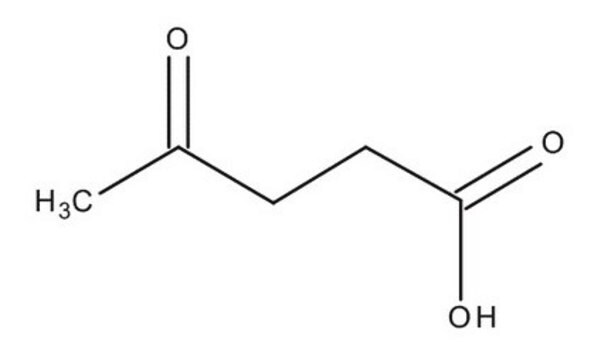41474
Levulinic acid
analytical standard
Sinônimo(s):
4-Oxopentanoic acid, 4-Oxovaleric acid
About This Item
Produtos recomendados
grau
analytical standard
Nível de qualidade
pressão de vapor
1 mmHg ( 102 °C)
Ensaio
≥97.5% (GC)
97.5-102.5% (T)
prazo de validade
limited shelf life, expiry date on the label
técnica(s)
HPLC: suitable
gas chromatography (GC): suitable
p.e.
245-246 °C (lit.)
pf
30-33 °C (lit.)
densidade
1.134 g/mL at 25 °C (lit.)
aplicação(ões)
cleaning products
cosmetics
flavors and fragrances
food and beverages
personal care
Formato
neat
cadeia de caracteres SMILES
CC(=O)CCC(O)=O
InChI
1S/C5H8O3/c1-4(6)2-3-5(7)8/h2-3H2,1H3,(H,7,8)
chave InChI
JOOXCMJARBKPKM-UHFFFAOYSA-N
Procurando produtos similares? Visita Guia de comparação de produtos
Descrição geral
Aplicação
for the quantification of the analyte in the following:
- Soy sauce using liquid chromatography coupled to mass spectrometry (LC–MS).
- Liquid food samples using gas chromatography with flame ionization detection (GC-FID).
Palavra indicadora
Danger
Frases de perigo
Declarações de precaução
Classificações de perigo
Acute Tox. 4 Oral - Eye Dam. 1 - Skin Sens. 1
Código de classe de armazenamento
13 - Non Combustible Solids
Classe de risco de água (WGK)
WGK 2
Ponto de fulgor (°F)
208.4 °F - closed cup
Ponto de fulgor (°C)
98 °C - closed cup
Escolha uma das versões mais recentes:
Certificados de análise (COA)
Não está vendo a versão correta?
Se precisar de uma versão específica, você pode procurar um certificado específico pelo número do lote ou da remessa.
Já possui este produto?
Encontre a documentação dos produtos que você adquiriu recentemente na biblioteca de documentos.
Os clientes também visualizaram
Nossa equipe de cientistas tem experiência em todas as áreas de pesquisa, incluindo Life Sciences, ciência de materiais, síntese química, cromatografia, química analítica e muitas outras.
Entre em contato com a assistência técnica







